NZXT Phantom 630 Case Review: The Relentless Pursuit of Perfection
by Dustin Sklavos on January 20, 2013 12:01 AM ESTNoise and Thermal Testing, Overclocked
A case like the NZXT Phantom 630 isn't meant to run hardware at stock settings; it's designed for end users who want to push their systems as far as they can go. My experiences with Ivy Bridge and Kepler suggest that for current generation hardware, this is especially relevant, with Kepler in particular having its boost clocks being governed by relatively low thermal thresholds.
Our overclocked testbed tends to put a healthy amount of stress on system cooling, but you're about to see the Phantom 630 hit another grand slam and obsolete its older, more expensive sibling.
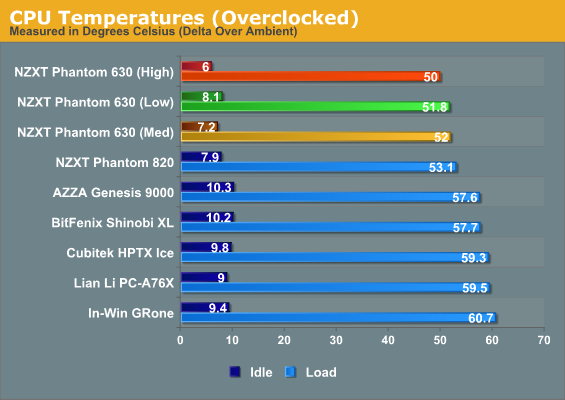
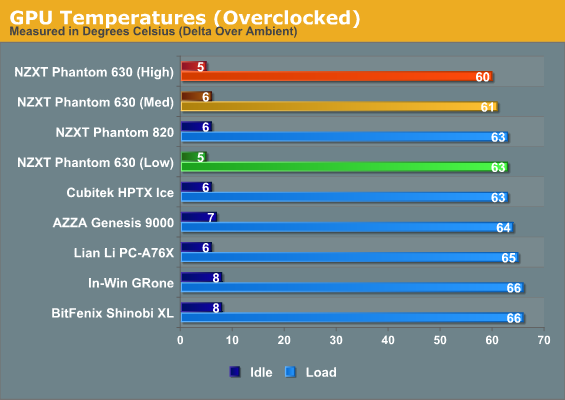
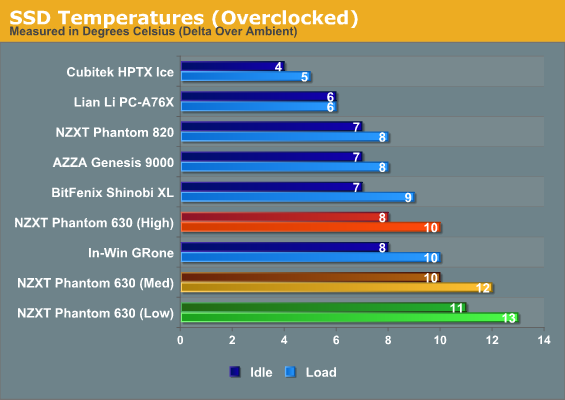
So this is pretty much what progress looks like. The SSD again runs toastier behind the motherboard tray than it does in the other enclosures, but not even close enough to affect usability; add another 10C to start approaching that threshold. If you run the Phantom 820 at its absolute highest fan setting, it can produce ever-so-slightly better CPU thermals than the 630 can, but just barely above the margin of error. The 630 just has a more efficient airflow design.

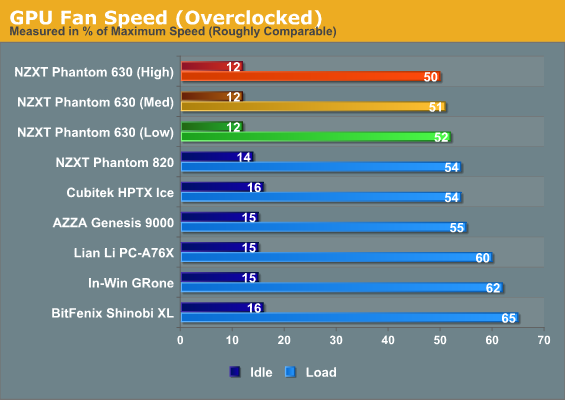
Airflow at the fan's high setting keeps the cooler on the CPU from hitting its inflection point, at which point it would have to spin up to a much higher setting. Fan headroom is still decent, but we're definitely pushing the cooling power of our CoolerMaster Hyper 212 Evo a little.
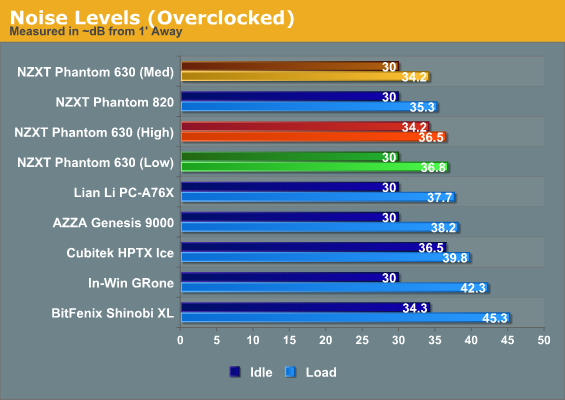
Say it with me, now: superior airflow almost always trumps acoustic padding. The Phantom 630's medium fan setting is most definitely its sweet spot, and the excellent flow through of the case keeps the heatsink fans from ever having to spin up too much. The 630 does a particularly excellent job of keeping our GTX 560 Ti cool even under its overclocked settings.










44 Comments
View All Comments
praeses - Friday, January 25, 2013 - link
Like Dustin pointed out, it would be nice to see fewer 5.25" drive bays and shed the side panel fan but I would like to see it one step further yet. I would like to see all 5.25" bays removed and just fans at the front.I am sure there are many others that would agree that in their high performance system (gaming, workstation, etc) there isn't a need for either 5.25" or 3.5" drive bays, only a couple 2.5" ones that this conveniently already has. The optical drive is nicely served externally up on the desk near the monitor/keyboard/mouse. The front could then sport another large (200 or 140mm) quiet fan directly in line with the CPU.
Also, a front fan filter and having the air redirected like the fractal design refine series (although their thermals aren't the best) would help muffle the sound.
Aesthetics I'm not a fan of but it wouldn't prevent me from buying one, the rest of the design I am quite fond of.
Magichands8 - Sunday, January 27, 2013 - link
What they should do is move the drives all up ABOVE the motherboard in a separate compartment a la Lian Li's Tyr PCX-2000 cases. You could pack them pretty tight too and still have room for nice amount of storage AND an optical drive. Then, you could place 2 200mm fans in the front, remove the top fan(s), remove the side fan and have a solid panel there instead. Thermals should be AT LEAST as good and the case would be much quieter to boot. Sure the case would be taller but I'd rather have something better designed from an engineering and performance standpoint than something that sucked but looked prettier. Besides, no one looking for a compact, small case should even be thinking about this one in the first place so I don't get all the talk about it being x millimeters taller or wider than the other case.I just don't get why so many companies these days stick to this silly and outdated approach of placing the drives directly in front of the motherboard. Cooling HDDs TOO well can actually reduce their life-span and it makes no sense to pre-warm the incoming air before sending it to the CPU. Why is it that we are starting to see all these removable and modular drive cages anyway? It's because people keep trying to find a way to get the damn drives away from the front of the case.
Targon - Monday, February 6, 2017 - link
I personally have a need for the four 5.25 inch drive bays. I went with a Icy Dock Fatcage, converts 3 5.25 inch drive bays into 5 3.5 inch hot swap bays(useful for RAID 1 and 5). For the rest, others may not care about having external hot swap bays, so having the drive bays can come in handy for those who use a lot of drives.LS& - Friday, November 22, 2013 - link
I just want to say thank you for your case reviews with temps as a solid focus. I have not built a pc in 7 years and am now just starting to do my research to find the best parts. Overclocking is going to be a goal in this build and at least for me low noise and great thermal is the key. Does anyone else know of any other cases well under $200 I should be looking at for this mix of sound and performance?